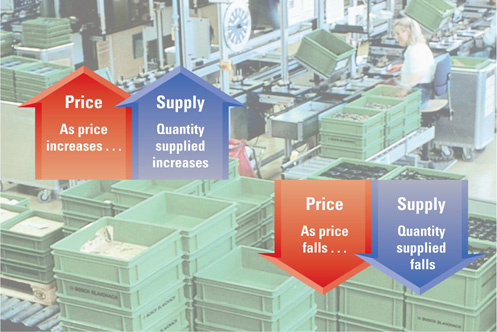Section 1 Understanding Supply
Preview
Objectives
After studying this section you will be able to:
- Explain the law of supply.
- Interpret a supply graph using a supply schedule.
- Explain the relationship between elasticity of supply and time.
Section Focus
The law of supply predicts that producers will offer more of a good as its price goes up. How strongly producers react to a change in price depends on their ability to raise or lower output.
Key Terms
- supply
- law of supply
- quantity supplied
- supply schedule
- variable
- market supply schedule
- supply curve
- market supply curve
- elasticity of supply
If you were running a business, what would you do if you discovered that customers were suddenly willing to pay twice as much for your product? If you were like most entrepreneurs, you would try to produce more in order to take advantage of the higher prices. Even if you used the higher prices as a way to work fewer hours while earning the same income, you could be sure that someone else would jump into the market and start selling the same good.
The Law of Supply
Supply is the amount of goods available. How do producers decide how much to supply? According to the law of supply, the higher the price, the larger the quantity produced. Economists use the term quantity supplied to describe how much of a good is offered for sale at a specific price.
The law of supply develops from the choices of both current and new producers of a good. As the price of a good rises, existing firms will produce more in order to earn additional revenue. At the same time, new firms will have an incentive to enter the market to earn a profit for themselves. If the price of a good falls, some firms will produce less, and others might drop out of the market.
These two movements—individual firms changing their level of production and firms entering or exiting the market—combine to create the law of supply.
Higher Production
If a firm is already earning a profit by selling a good, then an increase in the price—ceteris paribus—will increase the firm's profits. The promise of higher revenues for each sale also encourages the firm to produce more. Consider the pizzeria you read about in Chapter 4. The pizzeria is probably making a reasonable profit by selling a certain number of slices a day at the market price. If the pizzeria weren't making a profit, the owner would soon try to raise the price or switch from pizzas to something more profitable.

Figure 5.1 Law of Supply




